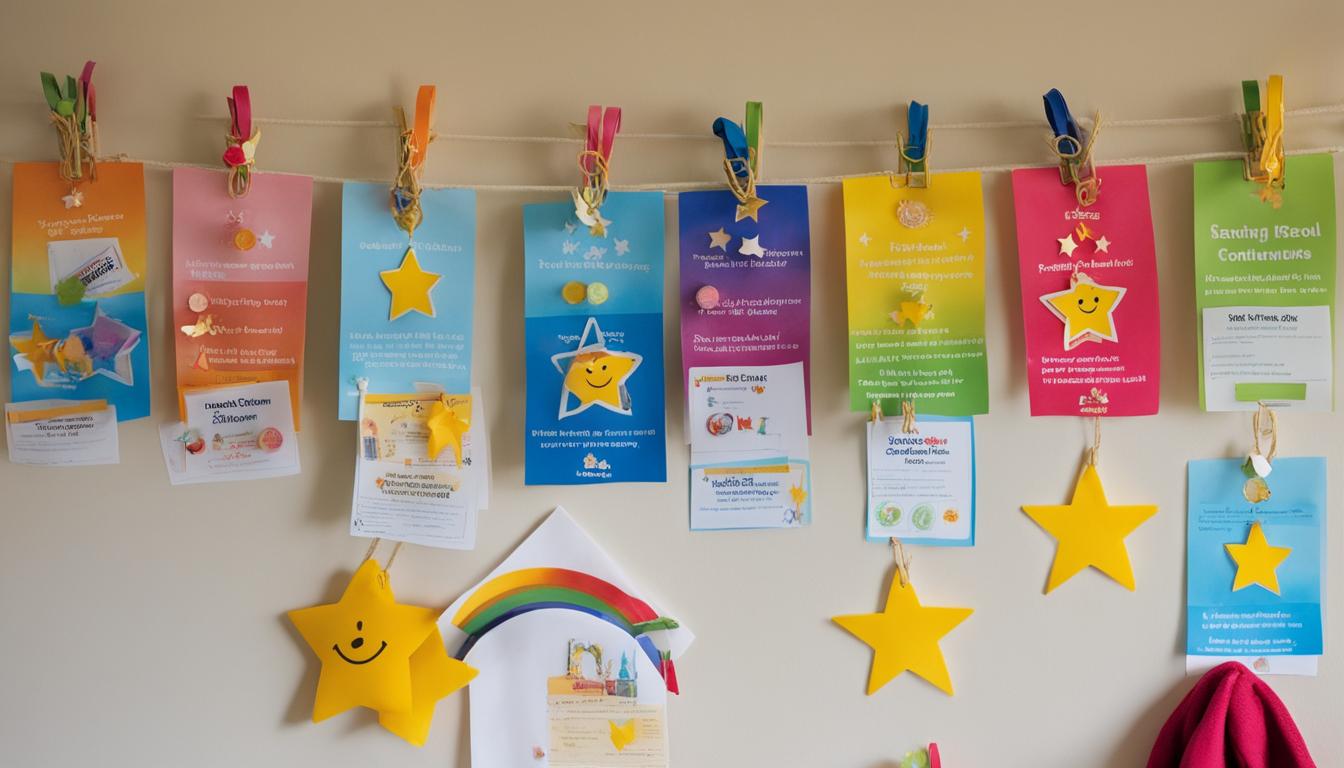Effective Reward Systems for Kids’ Behavior Management Tips
As a parent who’s observed the remarkable transformation in kids’ behavior courtesy of well-implemented reward systems, I’ve come to regard these strategies as invaluable tools in the realm of behavior management. Gone are the days when punitive measures stood as the sole tactic for correcting undesired actions in children. Today, incentives for children in the form of positive reinforcement have taken center stage, proving not only to be gentle but also immensely effective. This approach aligns seamlessly with my experience and that of numerous practitioners in the field.
Much more than simple behavior modification, these reward systems for kids have proven to be a dynamic means of behavior tracking, helping to build self-esteem, foster responsibility, and significantly decrease stress levels for both the child and parent. By embedding consistency and thoughtful incentives into the heart of these systems, positive behaviors are not only introduced but reinforced, leading to long-lasting change in a child’s conduct and approach to tasks.
Join me as I delve into the ingenious world of crafting incentive-based behavior frameworks. In exploring what experts like Anisha Patel-Dunn, DO, and Kate Eshleman, PsyD, advocate for, we gain insights into this progressive approach to childhood development. The idea here is not just to compell compliance, but to ignite an internal motor within these vibrant young minds that drives them to recognize boundaries, nurture independence, and most importantly, develop a resilient and positive self-image.
Skip To The Following Sections
- Understanding the Impact of Reward Systems on Child Behavior
- Designing Age-Appropriate Reward Strategies
- Consistency and Involvement: Keys to Successful Behavior Rewards
- FAQ
- What are reward systems for kids and how do they support behavior management?
- How does positive reinforcement through reward systems impact child behavior?
- What are some examples of age-appropriate reward strategies for children?
- How can I incorporate behavior charts and tokens into my child’s daily routines?
- Why is it important to align rewards with a child’s developmental stage?
- How important is consistency in applying behavior rewards with my child?
- What role does parental involvement play in successful behavior management?
- Can behavior charts or token economies be used for managing groups of children?
- Are there any risks associated with using reward systems for kids’ behavior?
- How can I ensure the rewards I choose are meaningful to my child?
- Source Links
Key Takeaways
- Reward systems for kids are effective tools for positive behavior reinforcement.
- Behavior management can be greatly enhanced through the use of tailored incentives.
- Consistently applying rewards leads to sustainable behavior modification.
- Choosing meaningful and attainable incentives for children is key.
- Parent-child collaboration in the reward process strengthens mutual trust and fosters responsibility.
- Behavior tracking allows for acknowledgment of progress, keeping both parent and child focused on positive change.
Understanding the Impact of Reward Systems on Child Behavior
I’ve witnessed the profound influence that reward systems have on child behavior. These systems, pivotal in the domain of behavior management, harness the impact of positive reinforcement to mold and refine the actions of young individuals. Their effectiveness lies in the capacity to underscore constructive behavior, which, in turn, fosters self-esteem and motivates a child toward consistent demonstration of such behaviors.
As I explore the variety of approaches employed to guide child behavior, it’s evident that the strategy must be thoroughly tailored. Each child’s age, unique personality, and interests are vital considerations when designing a reward system. By setting clear expectations and delivering immediate rewards upon desirable behavior, children are emboldened to participate eagerly within the framework established for their social-emotional development.
The efficacious nature of these systems lies in their ability to create compelling encounters for children with their achievements—encounters that both celebrate their milestones and encourage future positive endeavors.
When we talk about the impact of reward systems on child behavior, we are discussing a dynamic force that advances their development. These rewards range from additional screen time and deferred bedtimes to tangible forms of currency—all shaped to align with each child’s bespoke needs and wishes.
- Frequent praise
- Patient guidance in acquiring new skills
- Strategic involvement of the child in the process of selecting rewards
These elements, when cohesively combined, create an atmosphere ripe for the reinforcement of positive behavior, fostering a sense of accomplishment and eagerness within the child to continue on this constructive path.
An essential facet of this approach is the recognition of social-emotional development milestones, as children reach new heights in their interactions and understanding of empathy and social cues. By employing these reward mechanisms, we can cater to these developmental subtleties, cultivating not just a momentary willingness to comply but a variegated growth across a spectrum of social, emotional, and intellectual domains.

In harnessing the powerful tool of positive reinforcement through inventive reward systems, I have observed a remarkable evolution in child behavior. These systems do not merely adjust actions but also contribute to a child’s blossoming into a well-rounded individual, capable of navigating the complex social landscapes of their worlds with grace and confidence.
Designing Age-Appropriate Reward Strategies
As I venture through the nuances of child behavior, I’ve discovered that tailoring reward systems to align with a child’s developmental stage is an art form in itself. In my exploration, I’ve found that positive reinforcement is a cornerstone in shaping young minds, effectively steering them through the stages of growth. It is a powerful ally in the realm of behavior modification techniques.
Positive Reinforcement and Its Role in Shaping Young Minds
I have observed how powerful positive reinforcement is as a method for shaping young minds. Real, tangible progress can be seen when children are praised with phrases like, “Great job putting your toys away!” Such affirmation encourages the blossoming of self-confidence and the development of personal responsibility.
For toddlers and preschoolers, I’ve noticed how immediate and intimate rewards like high fives or exuberant praise can be more effective than any toy or treat. These age-appropriate reward strategies don’t just communicate approval, they are integral to fostering a warm and supportive environment.
Incorporating Behavior Charts and Tokens in Daily Routines
As children grow, integrating behavior charts and token economy systems into their daily routines offers a visual and interactive experience of tracking their behavior. I’ve seen sticker charts trigger exuberance in younger children, while points and play money serve as the currency for school-aged kids’ accomplishments.
In my engagement with families, small tasks like beaming a proud smile when handing out a gold star, or ringing a bell each time a point is scored, solidifies these as vital behavior management tools. The experience is gamified and the joy their faces reflect is indelible, a testament to the system’s efficacy.

Aligning Rewards with Developmental Stages for Maximum Benefit
Considering a child’s developmental stage when aligning rewards is a strategy I’ve witnessed yield the maximum benefit. For example, while older children might find their stride in a token system–amassing points for a book or a special outing–younger children often revel in the simplicity of exultant hugs or an extra story at bedtime.
We had a breakthrough the moment we replaced generic rewards with ones that resonated personally with each child—this is where I saw behavior truly start to transform.
Implementing a system with behavior rewards that grow with the child necessitates both flexibility and a keen perceptiveness on the part of parents or caregivers. Throughout my career, I have championed for rewards designed to parallel a child’s expanding horizon, nurturing their evolving interests and ensuring each milestone is celebrated fittingly.
- Real-time acknowledgment for toddlers with stickers and claps,
- Token accumulation for school children with sights on a prized possession,
- Milestone celebrations for tweens, marking their transition into more sophisticated reward systems.
The essential principle here is to align rewards with both the desired behavior and the child’s capacity for achievement. A shared joy between parent and child in each success story, big or small, helps cement the positive behaviors intended by these strategies.
Encapsulating my experiences and observations, it is evident that the fabric of effective reward systems is woven with threads of understanding, adaptability, and love. Together, these elements form a tapestry that brings out the best in our children, guiding them toward a brighter and more responsible future.
Consistency and Involvement: Keys to Successful Behavior Rewards
In my journey through different parenting strategies, I’ve come to understand that the backbone of successful behavior management hinges on two fundamental principles: consistency in behavior rewards and parental involvement. It’s the steadfast dedication of parents—committed to nurturing and reinforcing positive actions—that truly turns the tide in a child’s development. Not only does this approach anchor a system of rewards, but it also deeply instills values, turning good behavior into establishing healthy habits.
Embarking on this collaborative process, I’ve noticed that involving children in the selection of their rewards multiplies their value manifold. This inclusion fosters a sense of autonomy and decision-making in young minds. More than just a transactional acknowledgment, this is an investment in one’s growth. I’ve seen it work wonders in real-time, where choices made together have turned routine tasks into eagerly anticipated activities. Effectively, this co-creation of the reward space is a microcosm of the broader journey of life where healthy collaboration and mutual respect pave the way forward.
Communication, too, is a pillar in this construction of behavior rewards. Keeping children apprised of what’s expected while drawing attention to the benefits of positive outcomes enhances their engagement. It is evident that when parents maintain a clear, consistent message about the significance and mechanics of a reward system, they lay the groundwork for growth. This is where patience reveals its true colors as a virtue, allowing the learning curve to bend towards a burgeoning of character and capability. The crux lies in creating a rhythm of recognition and celebration, where the cadence of consistency meets the melody of effort, and together they harmonize in the symphony of successful behavior management.
FAQ
What are reward systems for kids and how do they support behavior management?
Reward systems for kids are behavior management tools that encourage positive behavior through the use of incentives. They replace punishment with positive reinforcement and can be tailored to each child’s developmental stage and personal needs. With these systems, children earn rewards for demonstrating desired behaviors, which helps them learn to gravitate toward good behavior over time.
How does positive reinforcement through reward systems impact child behavior?
Positive reinforcement impacts child behavior by emphasizing and rewarding good behavior, thereby building a child’s self-esteem and creating a consistent desire to repeat those behaviors. Reward systems like behavior charts or token economies should be customized based on the child’s interests and personality, and rewards should be given immediately after the desired behavior to be most effective.
What are some examples of age-appropriate reward strategies for children?
For younger children, examples include stickers, extra playtime, or verbal praise for specific actions. Middle childhood can involve more complex rewards such as additional screen time or earning tokens for completing homework. As children get older, incentives might evolve to include larger privileges or items that reflect their matured interests and responsibilities.
How can I incorporate behavior charts and tokens into my child’s daily routines?
Behavior charts and tokens can be seamlessly integrated into a child’s daily routine by identifying routine tasks and desired behaviors, then tracking them on the chart or with tokens. For example, a sticker chart can be used for young kids getting dressed on their own, and for older kids, tokens might be awarded for chores or homework completion. These can then be exchanged for rewards.
Why is it important to align rewards with a child’s developmental stage?
Aligning rewards with a child’s developmental stage ensures the reward system remains effective and engaging. What motivates a toddler is different from what motivates a teenager. As children grow, their needs, interests, and understanding of the world change. Rewards must be appropriate for their level of development to maximize the benefits and effectiveness of the reward system.
How important is consistency in applying behavior rewards with my child?
Consistency is incredibly important in behavior reward systems. It helps children understand the direct correlation between their behavior and the outcomes. When parents consistently reward good behavior, it reinforces the child’s understanding of expected behaviors and the reliability of the reward system. Inconsistent application can confuse children and reduce the system’s effectiveness.
What role does parental involvement play in successful behavior management?
Parental involvement is critical for successful behavior management. Parents who are engaged can better monitor their child’s progress, provide immediate and appropriate reinforcement, and are more likely to maintain the consistent application of the reward system. Involvement also includes working with the child to set goals and select rewards, which helps foster responsibility and decision-making skills.
Can behavior charts or token economies be used for managing groups of children?
Yes, behavior charts and token economies can be adapted for use with groups of children, such as in classrooms or during group activities. They can encourage positive behavior collectively, by setting group goals and rewarding the entire group for achieving them, which promotes teamwork and social responsibility.
Are there any risks associated with using reward systems for kids’ behavior?
Reward systems, if not implemented thoughtfully, can overemphasize material rewards or external validation, potentially undermining a child’s intrinsic motivation. It’s crucial to balance tangible rewards with social rewards like praise and to gradually help the child find their internal motivation for good behavior. Additionally, ensuring that rewards don’t become expected entitlements is key to maintaining their effectiveness.
How can I ensure the rewards I choose are meaningful to my child?
To ensure rewards are meaningful, involve your child in the decision-making process when possible. Discuss different reward options and gauge their excitement and interest in them. Remember to tailor the rewards to your child’s unique preferences and to vary the rewards periodically to maintain engagement.








